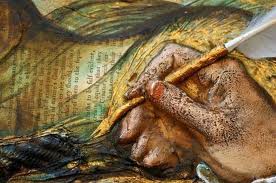A Guide to Writing about Art

This is an article concerning our beloved domain – ART! I wish to express my greetings to a website which allowed me the right of sharing this article: Thank You! Also, you are invited to visit the website as you will find more interesting things; a website which contributes to development of art:
The University of Iowa
[Source Info:
http://www.uiowa.edu/~writingc/writers/handouts/WritingAboutArt.shtml ]
A Guide to Writing about Art
“When you analyze, you are seeking to account for your experience of the work.”
“An unanswered question is an essay topic in disguise.”
We write about art to clarify and to account for our responses to works that interest, excite, or frustrate us. When writing a paper we not only look at what is in front of us, but what is within. Here is a basic checklist to keep in mind when drafting a paper:
- Interesting title.
- Intro includes essential info.
- There is a point (thesis).
- The point is well supported with persuasive details.
- The needs of the audience have been addressed.
- The paper is well organized.
- Personal views are included.
- It satisfies the assignment.
How to begin:
There are three main considerations when writing about art:
- subject matter
- form
- socio-historical context
Each of these affect the meaning or content you take away from a piece. In your analysis you might choose a single design element of the piece that illuminates your experience of it (i.e.: the scale of the piece, effect of gaze of the artist or viewer, the brushstrokes). When analyzing art, consider the following questions. After you answer each one remember to further ask yourself:
- Why the artist might have made that choice, and
- How does it affect the viewer’s reaction to, or relationship with, the piece?
General Questions:
- What is the title?
- Why was it made? What is its purpose?
- If it’s a portrait – does it portray an individual or a social type? What aspect of the sitter’s personality is expressed?
- If there is a figure, what is its gaze as it relates to the gaze of the artist or viewer?
- What is the relationship between the parts?
- What is the medium, color, scale?
- What techniques did the artist use?
- Where is it located?
- Are there any connections with earlier art history – or history in general?
- Is there any symbolism?
- What is the artist’s philosophy?
- Does the piece appear as it was originally constructed?
- What is the size?
- Where is the main subject in relation to the foreground, background and middle ground?
Drawing and Painting:
- If it is a still life, what does the artist focus on, technique, composition?
- In a landscape, is there any human interaction with the land? Whose view of the natural world might the artist have represented?
Sculpture:
- Is there a pose? What does the pose suggest?
- What does the clothing suggest? Is it heavy or light?
- Is the piece geometric? Irregular? In silhouette?
- If you are looking at a bust, note the truncation?
- Why would the sculptor chose to stop there? Is there a base?
- Is the sculpture carved or molded? What is its texture? Does it reflect the medium or the facture (the process of working on the medium)?
Photography:
- Who was the photographer, an individual or a firm?
- What is the overall focus?
- What type of development process was used; what kind of paper?
- On what material is the photograph printed?
- Has it been tinted, retouched or cropped?
- Was natural or artificial light used?
- What is the range of light and dark?
- What did the photographer chose for exposure time? Are there blurs or motions which indicate the passage of time?
Video Art:
- What is the visual impact? (Consider the work as you would a sculpture.)
- Is there sound?
- What is the context? (Of the video, of the piece as a whole.)
- Are there any political implications?
Architecture:
- How is the structural system of a building/monument suited to its purpose?
- What is the interior hierarchy of spaces? Do they flow, connect well to the exterior?
- What kind of statement does the building make about the thing it will house? (If it is a bank, what does it say about money? If it is a library, what does it say about knowledge?)
- How do you approach the building and enter it?
- Are there blueprints of the work? Do they change your impression of the building?
Please note: reproductions (in books or slides) offer little sense of the actual size and texture of the original. If possible, make an effort to see the work you are writing about or ask your professor to recommend a good book or website.
The information in this handout is excerpted from A Short Guide to Writing about Art (8th ed.), by Sylvan Barnet.
–The Writing Center thanks April Freely, Emma Rainey, and Emily Weirich for contributing this handout.
[for the article Full Rights Reserved ©The University of Iowa]




